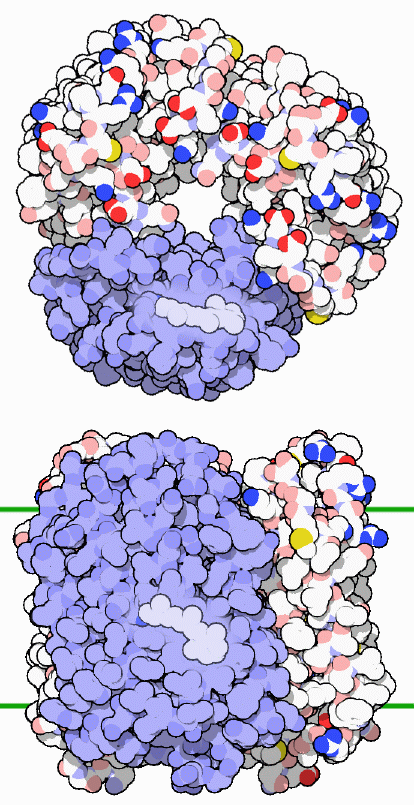|
Inhaltsübersicht | Nanomaschinen | Moleküle | Programme | Kurse | Fun | Links |
||
| > |
Bacteriorhodopsin

Sunlight powers the biological world. Through photosynthesis, plants capture sunlight and build sugars. These sugars then provide all of the starting materials for our growth and energy needs. As seen in the Molecule of Month last October, photosynthesis requires a complex collection of molecular antennas and photosystems. However, some archaebacteria have found a simpler solution to capturing sunlight.
A Light-driven Pump
Bacteriorhodopsin is a compact molecular machine that pumps protons across a membrane powered by green sunlight. It is built by halophilic (salt loving) archaebacteria, found in high-temperature brine pools. They use sunlight to pump protons outwards across their cell membranes, making the inside 10,000-fold more alkaline than the outside. These protons are then allowed to flow back inwards through another protein, ATP synthase, building much of the ATP that powers the cell.Capturing Light
Bacteriorhodopsin, shown here from PDB entry 1fbb, is composed of three protein chains. It is found embedded in dense arrays in the membranes of the archaebacteria. The area spanning the membrane is shown in the lower picture between the two green lines. At the heart of each protein chain is a molecule of retinal, which is bound deep inside the protein and connected through a lysine amino acid. In these pictures, one of the three protein chains is shown in blue and the retinal molecule, which is buried inside, is shown in white. Retinal contains a string of carbons that strongly absorb light. When a photon is absorbed, it causes a change in the conformation of the molecule. In bacteriorhodopsin, this is a change from a straight form to a bent form, as shown on a later page. This change in shape powers the pumping of protons.Many Uses
The capturing of light is so useful that these salt-loving archaebacteria actually build four different types of rhodopsins. Bacteriorhodopsin is used to generate energy. Halorhodopsin, which may be seen in PDB entry 1e12, is also a pump that funnels chloride ions instead of protons. It is in charge of keeping the internal concentration of chloride at high levels that match the salty conditions outside the cell. The other two rhodopsins are sensory rhodopsins, such as the ones in PDB entries 1h68 or 1jgj. These rhodopsins sense bluish light and send signals to the cell to move, finding an area with more useful, greenish light. All four of these rhodopsins are built along similar lines, with a retinal molecule securely held inside a compact container of protein.Next: Seeing Light
Last changed by: A.Honegger,